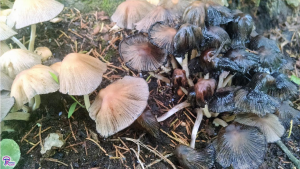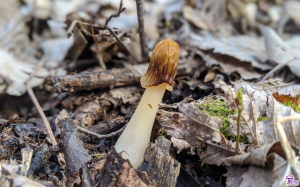#199: Entoloma abortivum, The Aborting Entoloma
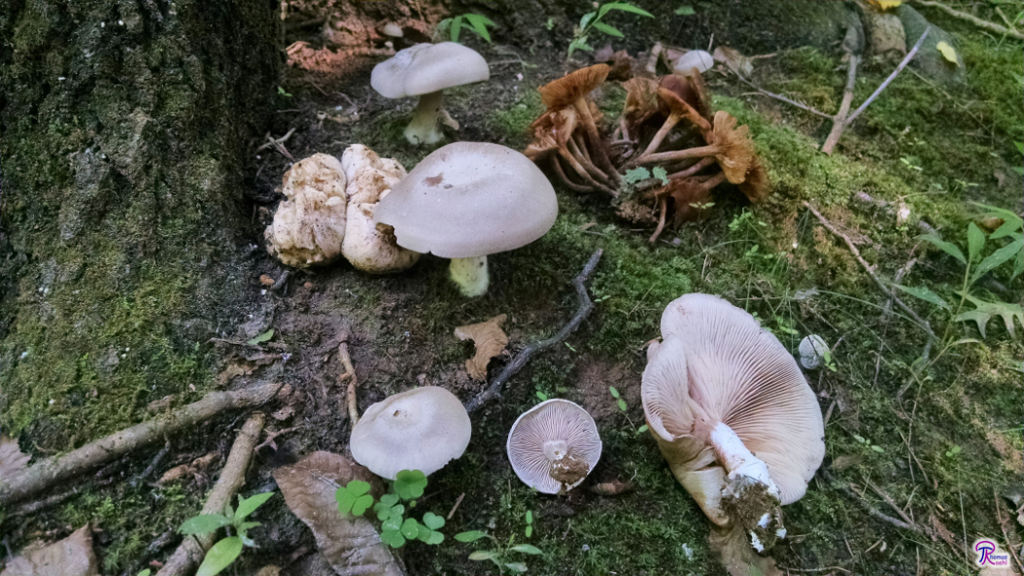
Entoloma abortivum produces both normal agaric fruiting bodies (front, center) and blob-like aborted fruitbodies (back left). The aborted forms are formed when E. abortivum parasitizes a honey mushroom, in this case Armillaria tabescens (back right, FFF#198).
Entoloma abortivum is a fascinating mushroom. The mushroom produces two forms of fruitbody: an agaric form that is an umbrella-like gilled mushroom and a “carpophoroid” (mycology-speak for “aborted”) form that looks like an oddly-shaped puffball. Both of these forms are usually found near honey mushrooms (Armillaria spp.) or in places honey mushrooms are known to grow. It turns out that E. abortivum is parasitic or partially parasitic on honey mushrooms; the aborted forms are actually the mycelium of E. abortivum attacking Armillaria mushrooms. Both the agaric and aborted forms are edible, although you need to be cautious when collecting Entoloma species.1–3
Description
E. abortivum is an agaric that produces medium-sized to large mushrooms with a circular pileus and central (or sometimes slightly off-center) stipe. The mushrooms are fairly regular in appearance and grow 2-10cm tall and 2-10cm wide. The mushrooms are not particularly interesting. The pileus is gray, sometimes with brown tones. It starts out convex and expands to become flat at maturity. Some mushrooms form a slight bump over the center of the cap, while others do not. On the underside of the cap, the mushroom forms gills that start whitish but turn pinkish as they age. The gills are slightly decurrent or sometimes are just attached to the stipe. The stipe is colored like the cap and usually has a bulbous base. It is most often smooth but can be slightly fuzzy. The base is normally covered in fuzzy white mycelium. E. abortivum produces a pink spore print, which is typical of Entoloma. Its flesh is white and firm and smells pleasant to mealy.2,3
The aborted form of E. abortivum is a truly bizarre mushroom. On the outside, it is white and discolors light brown. When sliced open, the flesh is spongy and marbled with patches of white and light pinkish brown. It produces no gills or any other regular hymenium. The entire structures are irregular globs that grow up to 2-10cm across. When they get old, the aborted forms often split in a + pattern at the center and become even more oddly-shaped. They often grow in clusters and usually have a pinched look at the base. Sometimes, you can thick black rhizomorphs attached at the base.2–4
Ecology
Both forms can be found in the late summer and fall, when honey mushrooms are also making fruitbodies. E. abortivum fruits on the ground near dead or dying trees, usually in places where honey mushrooms are also fruiting or have been seen in the past. The mushrooms are common in North America, inhabiting most places east of the Rocky Mountains.2,3
The relationship between E. abortivum and Armillaria spp. has been noted since the late 1800’s, but it was not until 1974 that someone tried to classify the relationship. After microscopic analysis, mycologist Roy Watling discovered that the aborted forms contained hyphae from both E. abortivum and Armillaria mellea. Since A. mellea was known to be an aggressive pathogen of trees, Watling hypothesized that A. mellea was also attacking E. abortivum and causing its mushrooms to abort. This hypothesis was not tested but seemed reasonable and became incorporated into field guides as fact.1,2
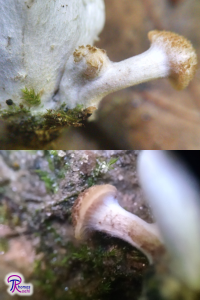
A half-aborted fruitbody of A. tabescens. The front side (top) has white mycelium covering all but the cap. The back side (bottom) shows the cap, gills, and stipe of A. tabescens only slightly covered with parasitic mycelium.
It was not until 2001 that mycologists questioned this assumption. A trio of mycologists led by Daniel L. Lindner Czederpiltz looked more closely at the aborted fruitbodies and found that half aborted fruitbodies sometimes formed that looked mostly like Armillaria species. They also found fully aborted forms that produced a partial veil, which is found in Armillaria but not Entoloma. These morphological features seemed to suggest that the Armillaria was the victim. Subsequent experiments growing the mushrooms in the laboratory showed that Armillaria mushrooms would abort when E. abortivum was present. This indicates that E. abortivum is parasitic on Armillaria, although the study’s authors admit it does not conclusively prove that relationship. Either way, it rules out the 1974 hypothesis.1,2,5
Most Entoloma species are decomposers of forest litter, so some authors suggest that E. abortivum is not exclusively parasitic. It seems reasonable to assume that E. abortivum still acts as a decomposer and acts as a parasite only when the opportunity presents itself. However, these theories have not been tested, so the precise ecological role of E. abortivum remains enigmatic. The best we can say now is that E. abortivum is probably parasitic on honey mushrooms and maybe saprobic.2
Similar Species
There are any number of Entoloma species that resemble the agaric form of E. abortivum. Entoloma is a very large and diverse genus, so it is not practical to list them all here. In general, Entoloma species can be recognized by their pink spores that are angular under the microscope, gills that attach to the stipe, and terrestrial habitat (see FFF#183 for more on Entoloma). Aside from the presence of aborted mushrooms, there are scant distinctive morphological features separating E. abortivum from some of its relatives.2,4,6
The aborted forms are quite unlike any other mushroom. The closest mushrooms in appearance are Amanita buttons and puffballs. However, both of those are much more regular in structure. Slicing the aborted forms in half easily distinguishes them, since they are the only mushrooms with a marbled interior.4
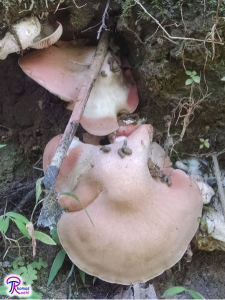
Entoloma species all have pink spore prints. This can be clearly seen on these E. abortivum mushrooms. After removing another mushroom from on top of the ones pictured, the pink spore deposit was clearly visible.
Edibility
Entoloma contains many poisonous species, so the general rule is that you should avoid eating all Entoloma mushrooms. However, the Aborting Entoloma is one species considered edible. Even the aborted forms are edible, since they are combinations of the edible E. abortivum and an edible Armillaria species.3,7
Many Entoloma species are poisonous and difficult to identify, so caution dictates that you should not eat the agaric form unless the aborted form is nearby. E. abortivum is the only Entoloma that makes aborted fruitbodies, so their presence allows you to bypass the labyrinthine world of Entoloma identification. That being said, you should still check any agaric form you collect against a field guide to make sure you haven’t collected a different species of Entoloma that just happened to be growing nearby. Collecting the agaric form of E. abortivum is apparently illegal in Michigan. Presumably, this is to prevent people from accidently collecting a poisonous look-alike.7 Wherever you are, it is recommended that beginners avoid eating the agaric form.
The agaric form of the Aborting Entoloma has a good texture and a mild flavor (I find it slightly beefy, but that could be due to cooking it in butter). I enjoy these mushrooms more than the aborted forms and honey mushrooms. The biggest problem with these mushrooms – aside from the possibility you’ve confused it with another Entoloma – is that they are difficult to clean. Dirt tends to get stuck in these mushrooms and you will bite into lots of gritty pieces even after thoroughly cleaning the mushrooms.
Aborted fruitbodies are much easier to identify, so they are a pretty safe edible mushroom. They do resemble puffballs and Amanita buttons, so it’s a good idea to cut the aborted forms in half before cooking them. They should have a tan/white marbled interior, while puffballs have a uniform white interior and Amanita buttons have the outline of gills and a stipe.3,4 The hardest part with the aborted forms is collecting good, fresh specimens, since they become waterlogged and buggy fairly quickly.7 Fortunately, it’s quite easy to tell which ones are worth collecting: when you squeeze the mushroom and it’s slimy or a cloud of flies rises out of it, don’t pick it. In my experience, the aborted forms are best before they split open at the top. These mushrooms can also get dirty, but most dirt is concentrated near the base and can be quickly cut out.7
Unsurprisingly, the aborted fruitbodies taste mostly like honey mushrooms, which have a stronger flavor than E. abortivum. Consequently, you will probably want to cook them like honey mushrooms. Honey mushrooms have a bitter flavor that mostly goes away after thorough cooking. They are also more likely than most edible mushrooms to make people sick (due to personal insensitivities that are poorly understood), so thorough cooking is advised. The simplest way to cook these mushrooms is sautéing them.4 Other people take a different approach: they cook it like shrimp. One of the mushroom’s common names is “shrimp of the woods,” presumably due to its texture. As a result, some people recommend sautéing it and then adding it to dishes in place of shrimp.8
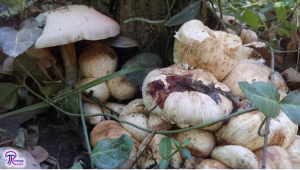
The aborted forms quickly get waterlogged and buggy. This cluster and a very large cloud of flies defending it.
Taxonomy
E. abortivum is placed in the genus Entoloma, a large genus containing pink-spored mushrooms with attached gills that grow from the ground.6,9 For some reason, MycoBank lists the current name for E. abortivum as Clitopilus abortivus (the genus Clitopilus is closely related to Entoloma, since both belong to the family Entolomataceae).10 All other sites, including Wikipedia11 and Index Fungorum,9 place it in the genus Entoloma. For that reason, I chose to use the name Entoloma abortivum in this post.
Many common names have been applied to E. abortivum: the “Aborting Entoloma,” “Abortive Entoloma,” “Hunter’s Heart,” “Ground Prune,” “Shrimp of the Woods,” and – in Mexico – Totlcoxcatl (which translates to “Turkey Wattle”).1,7 Most commonly, it is called the “Aborted Entoloma,” a holdover from the time when mycologists assumed that Armillaria parasitized E. abortivum. The name implies that E. abortivum is passive in the relationship, when it is actually the parasite. “Aborting Entoloma” and “Abortive Entoloma” imply that E. abortivum is active in the relationship, so they are slightly more fitting.1 I chose to use “Aborting Entoloma” because the words are slightly more usual.
| Common Name | Aborting Entoloma | Honey Mushrooms |
| Kingdom | Fungi | Fungi |
| Division (Phylum) | Basidiomycota | Basidiomycota |
| Subdivision (Subphylum) | Agaricomycotina | Agaricomycotina |
| Class | Agaricomycetes | Agaricomycetes |
| Subclass | Agaricomycetidae | Agaricomycetidae |
| Order | Agaricales | Agaricales |
| Family | Entolomataceae | Physalacriaceae |
| Genus | Entoloma | Armillaria (Fr.) Staude12 |
| Species | Entoloma abortivum (Berk. & M.A. Curtis) Donk9 |
This post does not contain enough information to positively identify any mushroom. When collecting for the table, always use a local field guide to identify your mushrooms down to species. If you need a quality, free field guide to North American mushrooms, I recommend Michael Kuo’s MushroomExpert.com. Remember: when in doubt, throw it out!
See Further:
http://www.mushroomexpert.com/entoloma_abortivum.html
http://www.messiah.edu/Oakes/fungi_on_wood/gilled%20fungi/species%20pages/Entoloma%20abortivum.htm
http://botit.botany.wisc.edu/toms_fungi/sep2006.html
http://botit.botany.wisc.edu/toms_fungi/entoloma.pdf
http://www.midwestmycology.org/Mushrooms/Species%20listed/Entoloma%20abortivum%20species.html
http://mushroom-collecting.com/mushroomentoloma.html
http://foragerchef.com/entoloma-abortivum-aborted-entoloma-mushroom/
Citations
- Volk, T. J. Entoloma abortivum, the Aborting Entoloma, a.k.a. Hunter’s Heart, Totlcoxcatl, or ‘ground prunes’. Tom Volk’s Fungi (2006). Available at: http://botit.botany.wisc.edu/toms_fungi/sep2006.html. (Accessed: 14th September 2017)
- Kuo, M. Entoloma abortivum. MushroomExpert.Com (2014). Available at: http://www.mushroomexpert.com/entoloma_abortivum.html. (Accessed: 14th September 2017)
- Emberger, G. Entoloma abortivum. Fungi on Wood (2008). Available at: http://www.messiah.edu/Oakes/fungi_on_wood/gilled%20fungi/species%20pages/Entoloma%20abortivum.htm. (Accessed: 14th September 2017)
- Spahr, D. Aborted Entoloma (Entoloma abortvitum). Mushroom-Collecting.com Available at: http://mushroom-collecting.com/mushroomentoloma.html. (Accessed: 14th September 2017)
- Czederpiltz, D. L. L., Volk, T. J. & Burdsall, H. H. Field Observations and Inoculation Experiments to Determine the Nature of the Carpophoroids Associated with Entoloma abortivum and Armillaria. Mycologia 93, 841–851 (2001).
- Kuo, M. Entolomatoid Mushrooms. MushroomExpert.Com (2013). Available at: http://www.mushroomexpert.com/entoloma.html. (Accessed: 14th September 2017)
- Entoloma abortivum. Midwest American Mycological Information Available at: http://www.midwestmycology.org/Mushrooms/Species%20listed/Entoloma%20abortivum%20species.html. (Accessed: 14th September 2017)
- Bergo, A. Aborted Entoloma Mushrooms. Forager | Chef (2012). Available at: http://foragerchef.com/entoloma-abortivum-aborted-entoloma-mushroom/. (Accessed: 14th September 2017)
- Record Details: Entoloma abortivum (Berk. & M.A. Curtis) Donk, Bull. bot. Gdns Buitenz. 18: 157 (1949). Index Fungorum Available at: http://www.indexfungorum.org/names/NamesRecord.asp?RecordID=297232. (Accessed: 14th September 2017)
- Entoloma abortivum. Mycobank Available at: http://www.mycobank.org/Biolomics.aspx?Table=Mycobank&Rec=247356&Fields=All. (Accessed: 14th September 2017)
- Entoloma abortivum. Wikipedia (2016).
- Armillaria. Mycobank Available at: http://www.mycobank.org/Biolomics.aspx?Table=Mycobank&Rec=56092&Fields=All. (Accessed: 14th September 2017)

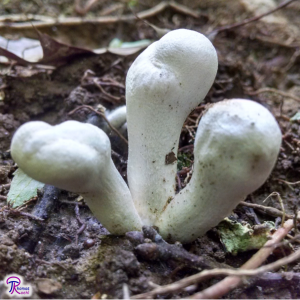
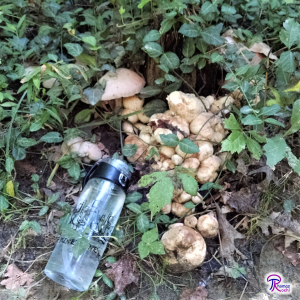
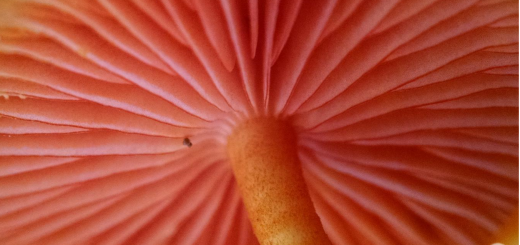

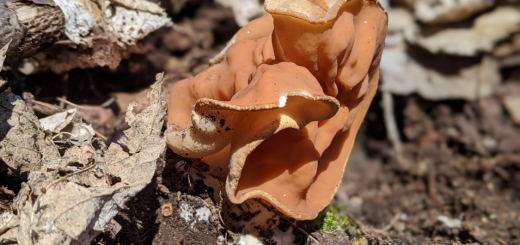





![#011: Characteristics of Kingdom Fungi [Archived]](https://www.fungusfactfriday.com/wp-content/themes/hueman/assets/front/img/thumb-small-empty.png)

